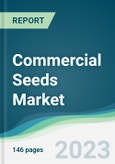The commercial seeds market was valued at US$49.537 billion in 2021 and is expected to grow at a CAGR of 5.1% to reach US$70.157 billion by 2028
The main factor of market expansion is the potential of commercial seeds to increase agricultural production while using less arable land. Additionally, increasing per capita disposable income is projected to lead to widespread and ineffective resource usage.Plant genetic codes can now be mapped more quickly and cheaply due to recent developments in molecular biology. By expanding their output with Genetically Modified (GM) seeds, farmers can effectively deal with key agricultural difficulties including increased demand.
Market Drivers
Concerns related to food security
Global concerns related to food security are developing as a result of the expanding world population and the resulting reduction of arable land. This is one of the main drivers boosting the need for commercial seeds to increase agricultural productivity. Moreover, governments in multiple nations are encouraging the use of sustainable agricultural methods through a variety of incentives, which is raising the demand for commercial organic seeds, and non-genetically modified organisms (GMO) seeds.In addition, several suppliers are providing hybrid seeds with excellent vigor, uniformity, and yield potential. Moreover, the advent of government programs to guarantee that crops cultivated through genetic engineering are safe for people, animals, and the environment is also assisting in the growth of the commercial seed industry.
- Increased productivity with commercial seeds
Furthermore, commercial seeds are increasingly being used to make cereal fodders including maize, sorghum, pearl millet, and oats, among others. This is due to the rise in livestock feed demand for energy-dense foods. As people's awareness of the environment grows, there is a growing need for biofuel crops, which is further aiding market growth.
North America and Asia Pacific regions are anticipated to hold significant market shares during the forecast period
- Regional market expansion for commercial seeds in North America is anticipated to be fueled by extensive R&D, favorable government laws, and the affordability of commercial seeds. Farmers are now obtaining more precise data due to the development of precision farming. It is believed that this would increase farmers' awareness of commercial seeds over conventional seeds.
- Over the projected period, South America is expected to grow at a notable CAGR. From small farmholders to professionalized mega farmers in Brazil and Argentina, agriculture is a significant part of the region's economic system.
- The agriculture industry in the Asia Pacific region includes both the most advanced technological standards in Japan and the most fundamental agricultural systems in nations like India. The prevalence of smallholders and the significance of rice are common features throughout the area. The majority (around 90%) of the world's rice production is in Asia, where India and China account for significant values.
Major market manufacturers
Syngenta International AG, Bayer AG, Monsanto Company, and DLF Seeds A/S are among the major commercial seed companies. The main techniques used by commercial seed suppliers to maintain competitiveness and enhance corporate performance are agreements and collaborations. For instance, top commercial seed suppliers, the Monsanto Company and Pairwise Plants collaborated to promote agricultural research and development via the use of gene-editing technologies.Market Developments
- In March 2023, Corteva Agriscience announced the launch of Vorceed Enlist® corn product range. In regions of significant corn rootworm (CRW) pressure in the Corn Belt, American farmers will have access to Vorceed Enlist corn technology through the exclusive Corteva Horizon Network.
- BASF is actively engaged in exploring and providing producers with ways to combat the Tomato Brown Rugose Fruit Virus (ToBRFV) epidemic since its early stages.
- In November 2022, The Kaduna-based seed firm SEED CO announced the availability of hybrid wheat seeds, millet, sorghum, and vegetables on the market as part of its mission to guarantee that Nigeria achieves high levels of food security and efficiency in agricultural production.
Market Segmentation:
By Ownership
- Proprietary Seeds
- Non-Proprietary Seeds
By Type
- Genetically Modified Seeds
- Conventional Seeds
By Crop Type
- Cereals
- Oilseeds
- Fruits and Vegetables
- Others
By Geography
- North America
- United States
- Canada
- Mexico
- South America
- Brazil
- Argentina
- Others
- Europe
- United Kingdom
- Germany
- France
- Spain
- Others
- Middle East and Africa
- Saudi Arabia
- UAE
- Israel
- Others
- Asia Pacific
- Japan
- China
- India
- South Korea
- Indonesia
- Thailand
- Others
Table of Contents
1. INTRODUCTION
2. RESEARCH METHODOLOGY
3. EXECUTIVE SUMMARY
4. MARKET DYNAMICS
5. COMMERCIAL SEEDS MARKET BY OWNERSHIP
6. COMMERCIAL SEEDS MARKET BY TYPE
7. COMMERCIAL SEEDS MARKET BY CROP TYPE
8. COMMERCIAL SEEDS MARKET BY GEOGRAPHY
9. COMPETITIVE ENVIRONMENT AND ANALYSIS
10. COMPANY PROFILES
Companies Mentioned
- Syngenta Crop Protection AG (Switzerland)
- Bayer AG (Germany)
- Land O'Lakes, Inc. (US)
- DLF Seeds A/S (Denmark)
- Sakata Seed America. (US)
- TAKII & CO., LTD. (Japan)
- Adama Agricultural Solutions Ltd. (Israel)
- KWS SAAT SE & Co. KGaA (Germany)
- Corteva Inc.
Methodology

LOADING...








